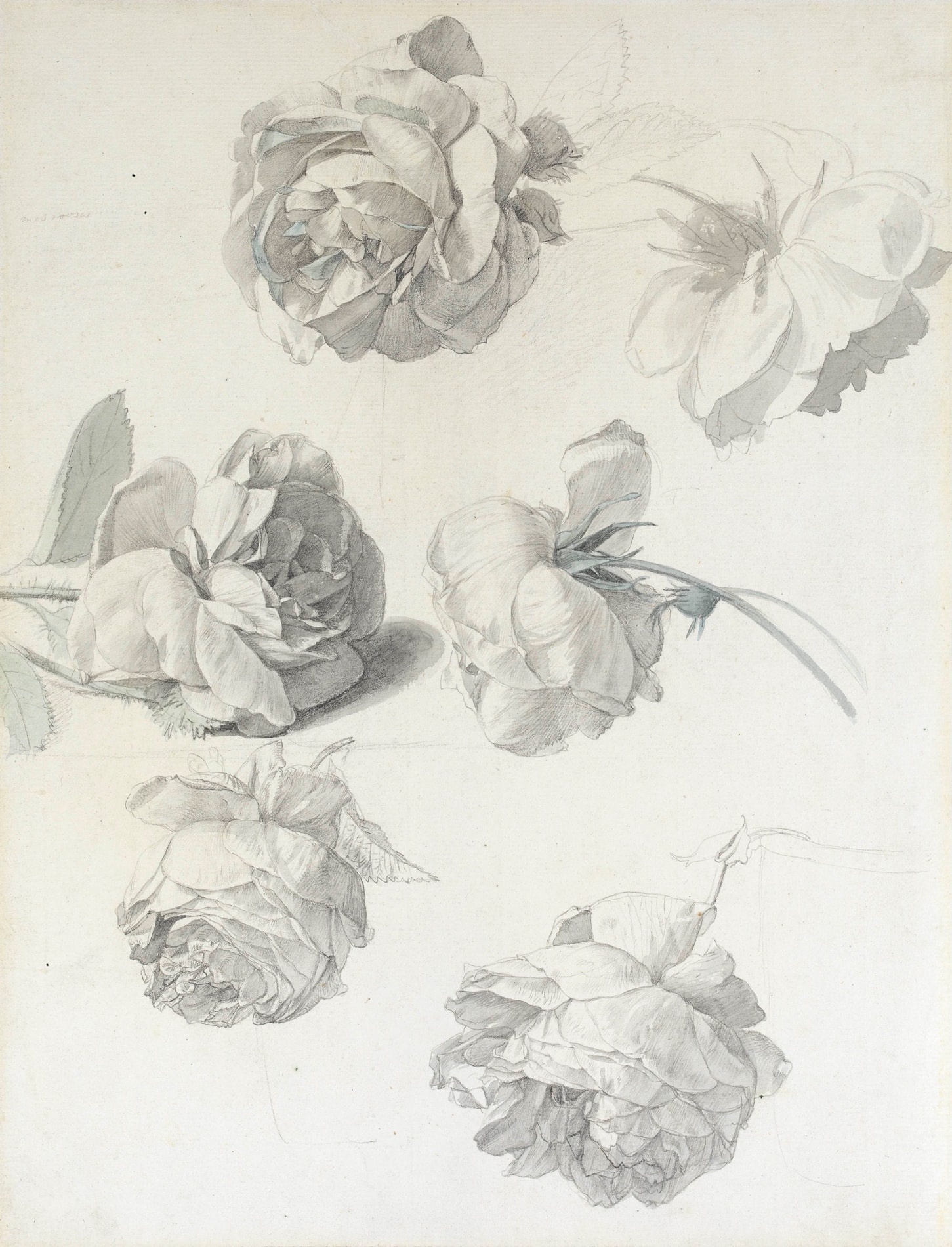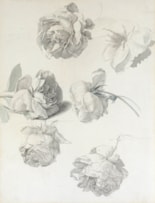Antoine BERJON
(Lyon 1754 - Lyon 1843)
Six Studies of Roses
Sold
Pencil, with gray and pale green washes, on light brown paper.
Faintly and indistinctly inscribed in pencil near the upper left corner.
370 x 282 mm. (14 1/2 x 11 1/8 in.)
Watermark: Fleur-de-lys above a shield.
Faintly and indistinctly inscribed in pencil near the upper left corner.
370 x 282 mm. (14 1/2 x 11 1/8 in.)
Watermark: Fleur-de-lys above a shield.
Berjon’s paintings and drawings are characterized by a meticulous technique and an attention to detail. Flowers and fruit are depicted with a great deal of scientific accuracy, the result of the artist’s studies in the botanical gardens in Lyon. Also typical of his work are restrained, uncluttered compositions and a particular delicacy of touch. As one modern scholar has noted of Berjon’s flower pictures, ‘One rarely finds in his own compositions the clever constructions of bouquets which were then so fashionable. Berjon preferred simple compositions, in which flowers and fruit are presented directly with some of that scientific precision, a characteristic of this genre of which he was in complete command, as well as a lively sense of the limpid atmosphere and soft light conducive to the harmonizing of delicate tones.’
This superbly drawn study of six roses belonged to the still life and landscape painter Eliot Hodgkin (1905-1987), who with his wife assembled a small but choice collection of paintings and drawings. According to a note on the old frame backing board, the attribution of this drawing to Berjon was first suggested by the critic Harley Preston, author of a brief account of some of the French paintings and drawings in the Hodgkin collection, published in 1985.
This superbly drawn study of six roses belonged to the still life and landscape painter Eliot Hodgkin (1905-1987), who with his wife assembled a small but choice collection of paintings and drawings. According to a note on the old frame backing board, the attribution of this drawing to Berjon was first suggested by the critic Harley Preston, author of a brief account of some of the French paintings and drawings in the Hodgkin collection, published in 1985.
Arguably the most important flower painter in France in the first half of the 19th century, Antoine Berjon worked mainly in his native Lyon. He is regarded as the founder and leading exponent of the Lyon school of flower painters; a particular speciality that traced its origins to the 18th century silk manufacturies in the city. The early years of Berjon’s career were spent as a fabric designer in the Lyonnais silk industry, though by 1791 he had made his debut at the Paris Salon, exhibiting three floral still lives and a pastel drawing of fruit and flowers. Berjon lived in Paris between 1793 and 1810, working as a still life and portrait painter, but in 1810 returned to Lyon. There he was appointed a professor of floral design and painting at the recently founded École des Beaux-Arts, established by Napoleon in 1807 ‘to give tuition to artists whose talents will be devoted mainly to the silk industry’. He continued to send still life paintings to the Salons in Paris until 1819, and also exhibited occasionally in Lyon.
Although best known as a flower painter, he also painted portraits in oil and pastel and worked as a miniaturist and printmaker. Apparently a somewhat difficult character, Berjon resigned from his post at the École des Beaux-Arts in Lyon in 1823, though he continued to teach privately. He spent the last two decades of his life as something of a recluse, and produced a large number of drawings, only a few of which were sold. A few years after his death, several of his drawings of flowers were reproduced and published as a suite of twenty-six lithographs by the firm of Grobon Frères in Lyon. Significant groups of drawings by Berjon are today in the collections of both the Musée des Beaux-Arts and the Musée Historique des Tissus in Lyon.
Provenance
Eliot and Mimi Hodgkin, London.




